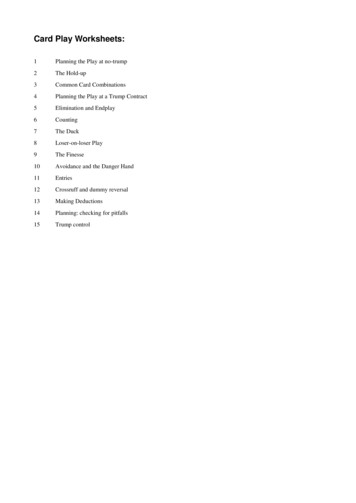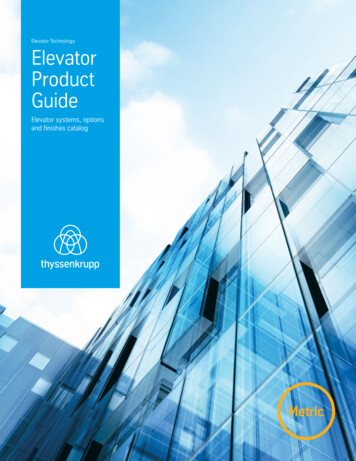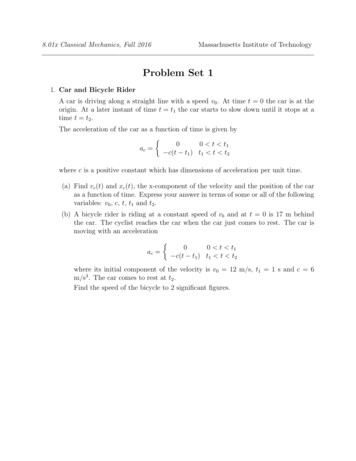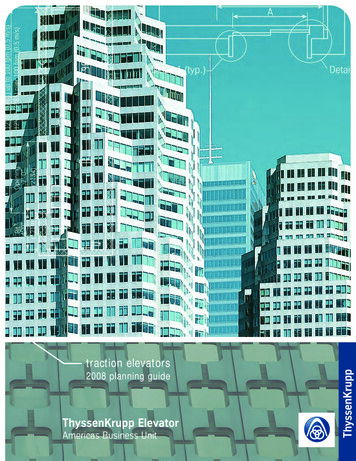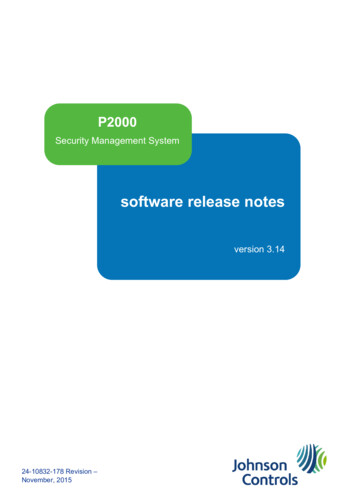
Transcription
PASS THE EIAT (ElevatorIndustry Aptitude Test)FIRST STEPS TO ACE THIS TRICKY TESTSample Questions & Tips
Dear Candidate,Passing the EIAT (Elevator Industry Aptitude Test) is a prerequisite for acceptanceinto any elevator apprenticeship.The main obstacle the EIAT poses for candidates is that a passing score is nearlynever enough, as applicants with higher test scores get precedence over those withlower scores.After years of research and preparing candidates for the EIAT test, we advise you tofamiliarize yourself with the different question types found on this test.In our experience, this should only be used as a first step, and thorough practice isessential for a top-tier score.You are welcome to read all about it on our website later.Good luck!JobTestPrep Team3
What Should You Expect on the EIAT Test? The EIAT contains 75-105 questions and takes around 1.5 hours to complete. The EIAT test contains 3 sections and 7 main question types: Math: Basic Numeracy, Fractions and Decimals Verbal: Vocabulary, Sentence Completion Mechanical: Gears, Wheels and Pulleys, Force and Torque Other question types may appear (especially in the mechanical section), but theseven types above are most common. The test is taken in a pen-and-paper format. You are not allowed to use a calculator. Test scores are divided into 4 tiers. Since applicants are selected for anapprenticeship based on their scores, a higher EIAT score means better chances ofan apprenticeship.See the score index on the next page4
EIAT Scoring TiersTierEIAT Score RangeTier 196-100Tier 290-95Tier 380-89Tier 470-79Fail69 and lower5
Questions and Full ExplanationsTo help you pass the Elevator Industry Aptitude Test, we at JobTestPrep createdsample questions accurately simulating those found on the actual test. Eachquestion is followed by a detailed solution.This is but a small portion of the questions and answers you will find on theJobTestPrep EIAT Test Preparation Pack.You may also check out a free sample EIAT test covering all 3 test sections.6
Math1. Basic NumeracyThis question type revolves around performing basic calculations without acalculator.You should showcase your command of the four operations (addition,subtraction, multiplication, and division), and BEDMAS.Due to the large number of questions on the test, it is important to createaccurate yet quick solving techniques. Let’s see an example.142 x 37 ?A.B.C.D.E.3,7425,1805,2542,7444,211Answer and ExplanationWhen approaching a question dealing with the multiplication of fairly largenumbers, it is recommended to first use the “last digit method”:The Last Digit MethodMultiply only the two last digits. The last digit of thismultiplication must be similar to the last digit of the finalresult.7
In our case:2 x 7 14 The last digit is 4.Therefore, the answer should be either C (5,244) or D (2,744).Now, let’s combine this method with the “first digit method”.The First Digit MethodMultiply the first two digits (and add zeros) – the final resultwill be larger.In our case:1(00) x 3(0) 3(000) 3,000Since 142 x 37 100 x 30, the result should be larger than 3,000 C (5,244)8
“Solving 35 calculationquestions can be veryexhausting. Developingcalculation shortcuts is agood method of relievingstress and preventingattention deficit.”9
2. Fractions and DecimalsThis type of question deals specifically with fractions, and covers areas such asimproper fractions, equivalent fractions, fraction to decimal conversion and viceversa, mixed fractions, etc.As on basic numeracy questions, using shortcut techniques here can be very helpful.Convert (23/200) to decimal:A.B.C.D.E.0.460.1150.0238.695.333Answer and ExplanationThe term “decimal” comes from the word “deca”, which is a prefix meaning “ten”(decimeter, decathlon, decibel).As such, it is most helpful to express the original fraction as some variation of tenths,hundredths, thousandths, etc.In our case:23/200 (23/2)/100 11.5/100 C 0.115TipWhen dividing by a multiple of ten, move the decimal pointto the left as the number of zeroes.10
Verbal1. VocabularyVocabulary questions assess how well you know the meaning of words,including synonyms and antonyms.Although these questions mostly rely on knowledge, there are severalmethods you can use to increase your chances of being correct.Colorful and outfits were worn by carnival participants in the main paradecrossing the capital city.A.B.C.D.dullflamboyantindolencesomberAnswer and ExplanationIf you are familiar with the meaning of all these words, then you probablyknow that the correct answer is B – flamboyant.However, even if you are not, there are several clues in the sentence andanswer options that can help you eliminate answers:- The word and suggests that the missing word should bear the same “spirit”as the word colorful. The words dull and somber are of an opposite spirit tocolorful, so they are eliminated.- The missing word should be an adjective as it refers to outfits. By the suffix“-ence” we know that indolence is a noun. Therefore, it is also eliminated.The correct answer is B – flamboyant.11
“EIAT test-takers often tend tooverlook the verbal section,but it is as important to yourscore as any other section.”12
2. Sentence CompletionThese questions are one level above vocabulary questions. Rather thanfocusing on the simple meanings of words, they assess your ability tounderstand the inherent meaning of a sentence and complete the missingwords accordingly.When employees, it is for the recruiter to evaluatecandidates' character.A.B.C.D.E.grading, not importanttalking, not necessaryFiltering, equivalentpromoting, essentialselecting, importantAnswer and ExplanationWe can see that answer options D and E are the only ones forming a logical andmeaningful sentence:A. When grading employees, it is not important for the recruiter to evaluatecandidates' character. – This is untrue as it naturally is important to evaluatecharacter when grading employees in a hiring process.B. When talking employees, it is not necessary for the recruiter to evaluatecandidates' character. – This option creates an incoherent sentence.C. When filtering employees, it is equivalent for the recruiter to evaluatecandidates' character. – This is an incoherent sentence as well.D. When promoting employees, it is essential for the recruiter to evaluate13
candidates' character.E. When selecting employees, it is important for the recruiter to evaluatecandidates' character.Although both sentences D and E are logical and coherent, only one of them can bethe correct answer.So, which one is it?The answer can be found when we closely look at the sentence.The word “recruiter” reveals that the sentence deals with recruitment – namely, theselection of new employees. As such, it cannot deal with promoting existingemployees.The correct answer is, therefore, E.Such tricky questions are not the standard on the EIAT test, but they willoccasionally appear, and will be the ones that will make the difference between atier 1 score and a tier 2 score, which is the difference between getting anapprenticeship in this recruitment and (maybe) next year.The EIAT Test Preparation Pack will get you familiar with such questions, so your levelof practice is more advanced than the actual EIAT test.14
Mechanical1. GearsQuestions on gears can be complex, but they are generally not very creative –all questions are generally based on a limited number of physical principles.Here is one such question, dealing with the principle of counting gears.In which direction will the swings tilt?A. A – Up, B - DownB. A – Down, B - UpC. Both DownD. Both UpAnswer and ExplanationWhen two gears mesh against each other, they rotate in opposite directions.You could track the rotational direction of each gear, but that puts you at highrisk for errors, especially in questions containing a large number of gears. Toavoid that, use the gear counting method:15
Counting GearsCount the number of gears between the rotating gear andthe last one. If the number is: Odd – the last gear rotates in the same direction asthe first. Even – the last gear rotates in an opposite direction.In our case: 4 gears separate the red gear from the last gear near swing A it rotates inthe opposite direction, namely clockwise. 1 gear separates the red gear from the last gear near swing B it rotates inthe same direction, namely counterclockwise.Therefore, swing A tilts down, and swing B tilts up.The correct answer is A – A-Down, B-Up.16
2. Wheels and PulleysQuestions on wheels and pulleys cover two topics that are very common onthe EIAT test: Wheels – these questions focus on the basic rules of wheels – therelationship between size and speed, rotational and linear velocity, etc. Pulleys – these questions will mostly depict two or more pulleysystems, and require you to determine which system is more effective(i.e. requires less force to operate). You will also need to understandthe relationship between force, work, and pulling distance.Which pulley system requires more force to lift the load?A. System AB. System BC. Both systems require equal forceAnswer and ExplanationAt first glance, it would appear that system B, having more wheels (3compared with only 2), will require less force to lift the load.However, the additional wheel does nothing to divide the force, and onlychanges the pulling from a linear movement in system A to a rotationalmovement in system B.The correct answer is C.17
For solving pulley questions correctly, it is crucial that you understand theconcepts behind pulley systems, and mainly the distinction between a movingand a fixed pulley.3. Force and TorqueOf all mechanical question types on the EIAT test, force and torque questionscover the broadest range of topics. Some examples include: Levers – the law of the lever, three lever types, etc. Springs – relationship between deflection and strength, series andparallel springs, etc. Torque – definition of torque (r X F), basic moment of area definition(resistance to bending), etc. Force – center of mass, force equilibrium, vectors, tension, etc.Which rower will find it harder to move the kayak?A. Rower AB. Rower BC. Both will find it equally difficult18
Answer and ExplanationThe kayak row is a lever of the 1st class, where one hand is the effort, the other is thefulcrum, and the water is the load, as seen in the following diagram:According to the Law of the Lever, the longer that distance, the more force the rowermust apply to move the row. Therefore, a longer row will be harder to move throughthe water.Therefore, the correct answer is A.TipIn mechanical questions depicting two scenarios, a goodtechnique to use is to “go to the extremes:”Go to the ExtremesTake both depicted scenarios and “stretch” it to theextreme. You will usually get a pretty good feeling for thecorrect answer.In our case, think of a one-foot-long paddle vs. a one-mile-long paddle. Clearly, it isgoing to be practically impossible to row with a mile-long paddle (even if it were ofzero weight).19
How Can JobTestPrep Help You Prepare?Over the years, JobTestPrep has helped over five thousand satisfied EIAT testtakers with their aptitude test.The Benefits:Coverage for all EIAT Test sections (including the toolsassessment)A diagnostic test to find and focus on your weak spotsStep-by-step explanationsBonus: Read the Technical Employee Personality Guide tounderstand how to pass the interview stage.24/7 Customer ServiceVisit JobTestPrep’s EIAT Page or search Google for "EIAT JobTestPrep" for themost comprehensive and accurate EIAT preparation available today.Want to try some more EIAT questions? Take a Free EIAT Sample Test (with fullanswers) and know where you stand compared to the required score.Take a Free EIAT Sample Test20
Passing the EIAT (Elevator Industry Aptitude Test) is a prerequisite for acceptance into any elevator apprenticeship. The main obstacle the EIAT poses for candidates is that a passing score is nearly never enough, as applicants with higher test scores get precedence over those with . elevator


